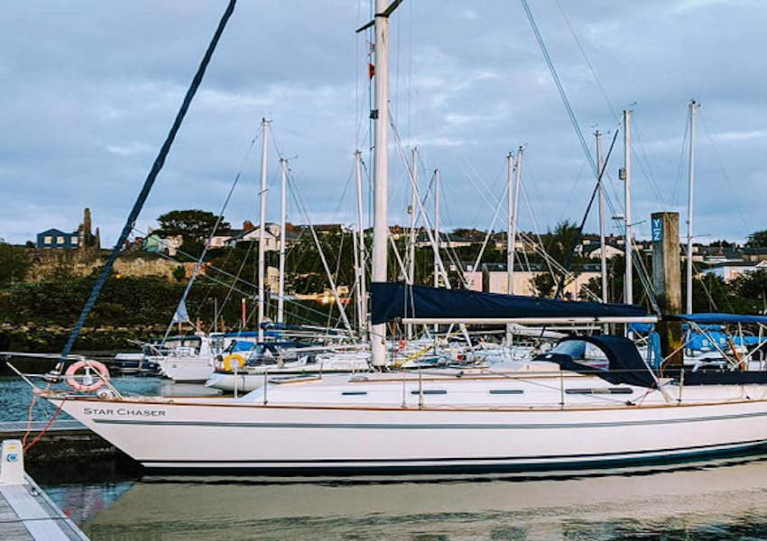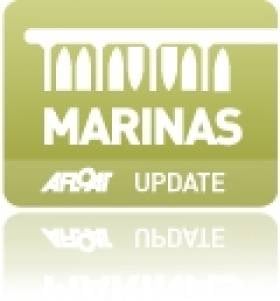Displaying items by tag: Quoile Yacht Club
Quoile Yacht Club in the southwestern corner of Strangford Lough held its annual two-day cruiser-racer event over the weekend of 20th and 21st August with 20 entries in three classes.
Sponsored by Ross Boyd Chartered Accountants and Mackey Opticians, the popular event ran two races on the Saturday and one on the Sunday.
 Quoile YC pontoons
Quoile YC pontoons
Strong South Westerlies gusting up to 30 knots got the event off to an exciting start but just after Race 1 got underway the wind had settled into a slightly more manageable 15-22 knots. Generally, the Saturday conditions tested the competitors who relished the challenge.
Sunday required very different sailing tactics as the breeze had dwindled away and racing began in a fickle four knot West/Southwest breeze which held all morning, allowing competitors to finish comfortably.
 Peter Holden’s J109, Going to Red
Peter Holden’s J109, Going to Red
In IRC, Peter Holden’s J109, Going to Red from Strangford Lough YC won all three races. Runner-up was Mike Spence’s A35, Le Basculer from Killyleagh and in third was the only visitor from outside the Lough, the O’Tiarnaigh/Mulholland/Harrington trio from Royal Ulster, Ballyholme and Sutton DC in the IMX 38 Excession.

The NHC class was topped by Michael Petticrew’s stunning Nicolson 43 Magdaleyne from East Down YC followed by the Maxi 999 Cascade (Harte & Orr from SLYC ), and Sea Jade, Maeve and Ian Bogie’s Seaquest (SLYC).
Two first places in the NHCRS division gave Stevie Andrews’ Hanse 371 Dark and Scary overall first with runner up Kyle Bolton’s Moody 31 Kilcuan (Killyleagh YC) and in third Green Ginger, Maria McGrogan’s Sigma 33 from SLYC.
 Molly Harwood's Leisure 17 Tara
Molly Harwood's Leisure 17 Tara
Echoing the encouragement given to young people racing in the Feva class at the RS event at Ballyholme the same weekend, it was good to witness the efforts of Molly Harwood’s young crew in the Leisure 17 Tara from Strangford Lough YC. Chloe Flemming (14), Aine Harwood (14) and Nikita Kirk (19) braved not only the lively winds on the Saturday, but also persevered with the much lighter winds on Sunday, finishing in first place in NHCRS in the final race.
The Quoile Yacht Club Spring Series on Northern Ireland waters kicked off the sailing programme on Strangford Lough at the end of April, racing in two fleets, IRC and NHC
The club is tucked away in the sheltered southwestern corner of the Lough and is an RYA training centre with mixed dinghy and cruiser-racer fleets as well as motor vessels.
The three IRC boats were all part of the surging East Down Yacht Club Impala fleet with James Curran’s Beeste topping the table with two firsts and a second. Runner up was John Patterson’s Maverick one point behind and in third was Imp (Grant McCullough).
 Peter Holden's Going to Red (under her old name)
Peter Holden's Going to Red (under her old name)
The seven-strong NHC fleet was won by Peter Holden’s J109 Going to Red counting two firsts and a second with Michael Petticrew’s Nich 43, Magdaleyne runner up with a second and a fourth. In third place was Stevie Andrews’ Hydro, Hydrology, basically, a Hydro 28 modified with a sugar scoop stern the same as the late Hugh Ennis’s well-known Moonlighter.
 Hydrology (Stevie Andrews)
Hydrology (Stevie Andrews)
Reportedly it was a fantastic weekend of sailing with mixed weather but nevertheless a most enjoyable event with which to start off the very full sailing programme.
Canoeists Add Splash of Life to NI’s Quoile Yacht Club As It Works to Broaden Watersport Appeal
The latest in the RYA’s Spotlight series puts the focus on Quoile Yacht Club as the Northern Ireland club tries to broaden its appeal beyond traditional events like its Spring Series.
“As a result of the COVID-19 pandemic, events around the lough had dwindled somewhat, and the activity around the club was generally quieter,” the Co Down club’s Vicky Bridges says.
“To give the club a boost and also to inject a bit of excitement and energy back into our Quoile Yacht Club weekends, we decided to get in contact with the Ulster Canoe Club, to offer them an opportunity to hold the Ulster Canoe Festival at our club.”
The event took place 3-5 September 2021 and Bridges says it was was “a roaring success”.
She adds: “This not only created visibility for the club – in that it meant that lots of advertising was taking place – but it also demonstrated to a whole new group of watersport enthusiasts that QYC was not just a one-sport club.
“Not only did we welcome 85 canoeists and their families, we also provided camping facilities for those who had tents, and made room for 20 camper vans. We hired catering and even had a local water sports shop set up a pop-up shop in the clubhouse.
“We were able to demonstrate that QYC is not just about sailing but is a weekend away, a family holiday, a peaceful break from your working week.”
Bridges emphasises that the overwhelming feedback, from club members up to the commodore, was that the event “had been a delight to host” and was enjoyed by all.
“Events such as this one have a positive impact on our club not only financially, but also socially,” she says. “QYC has now made valuable connections with like-minded clubs and organisations, who will support and work with the club in future.”
The future of watersport is very much on minds at the club, Bridges says, as a wider range of people move to activities such as open water swimming, paddle-boarding and canoeing — promoted by a new focus since the pandemic on improving mental health and wellbeing.
“An event such as this encourages the sustainability of the club as it creates enthusiasm, boosts accessibility and ultimately means that we end up with more membership applications,” she says.
“Going forward, QYC is keen to consider the various different water sports that we may be able to offer, and to continue to engage in partnerships such as these. We are currently considering any other sports that could be managed from our setting.
“Boating is that which we all have immense passion for and are very enthusiastic about – but we have learned from this experience that it is incredibly important to consider new trends and interests, and to move forward with these. This keeps our club current, attractive, growing and therefore thriving.”
Forty years has passed since the first Spring Series in Ireland took place at Quoile Yacht Club in Northern Ireland. The club lies in the southwestern corner of Strangford Lough and at that time the event was shared with Down Cruising Club at Ballydorn just north of Whiterock in the northwest of the Lough. Since the 1980s the series has been held annually at Quoile Yacht Club.
Traditionally, the series started on the last Sunday in March and ran over five consecutive weekends, with an extensive social programme organised ashore. Spring weather was typically mixed with lovely sunshine one weekend and then snow flurries and sleet the next. Sailing Secretary Lucy Anderson says “This year we are delighted to be hosting the first racing on Strangford Lough on 30th April and 1st May at Quoile Yacht Club and sailors are pleased and excited to get afloat”. There will be two races on the Saturday and one on the Sunday.
 Quoile Yacht Club lies in the southwestern corner of Strangford Lough
Quoile Yacht Club lies in the southwestern corner of Strangford Lough
In the past, the event was hugely popular with some 30-40 boats. Lucy continues; “I would say 40-50 boats this year. There is always a good turnout for the first racing of the year and it is also after the Easter break so all the sailors will have plenty of time to work on their boats”.
"The event is open to IRC, NHC, NHCRS and Squibs"
In the past local boats were also supported by yachts from Belfast Lough, Lough Neagh, and Lough Erne. At that time there were no marinas in Belfast Lough, and traditionally many of the yachts came to Strangford at the end of August and spent the winter at anchor in Ringhaddy and other winter moorings. Today, Quoile Yacht Club Spring Series has been consolidated into one weekend. The event is open to IRC, NHC, NHCRS and Squibs - and the surging one design Impala fleet will be out in force on the Lough this year. Lucy adds “We expect a huge response from the nine other clubs around the Lough. It would be fantastic if we had boats from Belfast Lough participating”.
There will be a dinner on the Saturday night in the clubhouse for the visitors staying over and members, and breakfast will be served for everyone on the Sunday morning.
How One Northern Ireland Sailor Kept His Spirits Up During Lockdown
Since his return to sailing with the lifting of coronavirus restrictions in Northern Ireland, Newcastle Yacht Club dinghy racer Marc Miskelly tells RYANI how he kept up a positive attitude during the lockdown months.
Miskelly — who also sails a Sadler 34, Star Chaser, out of Quoile Yacht Club — has just come out of a winter spent refitting his yacht when restrictions were put in place.
“I had two boats fully prepared very early, ready for the season, however with lockdown [they] were going nowhere,” he says of the time.
On top of that, Miskelly found himself furloughed from his job for up to 10 weeks — but resolved to keep himself busy with DIY jobs around the house, improving his personal fitness and even eSailing through his local club.
The call of the sea was never far from his mind, however, especially in May when he was supposed to have been cruising the Scottish islands in Star Chaser.
But since July he’s been making up for lost time, starting with cruising the East Coast of Ireland and hopefully embarking on that long-awaited jaunt around Scotland before autumn sets in.
Situated at the head of the Quoile River estuary on Castle Island. There is a short stay pontoon with water hose at Quoile Yacht Club. Visitors can anchor off the moored yachts between Castle and Gibbs Islands. No overnight berthing at the pontoon without permission.
Quoile Yacht Club
The Quoile Yacht Club was founded in Downpatrick at the Quoile Quay, on the then tidal Quoile River, in 1958. When, in 1962, the Ministry of Agriculture built a barrier at Castle Island, to alleviate the regular damaging flooding to which Downpatrick was subjected in times of high tide and heavy rain, they agreed to relocate the club to the seaward side of the barrier. The site was excavated and levelled, and a slipway provided. Thus the Club was reborn on its present site, with sheltered deepwater moorings, space for caravans, clubhouse and parking. After 40 years of investment and improvement the Quoile can boast the best facilities on Strangford Lough.
Quoile Yacht Club, 21 Castle Island Road, Downpatrick, Co. Down BT30 7LD, N. Ireland. Tel: 028 4461 2266, Club Secretary email: [email protected]
(Details courtesy of Quoile Yacht Club)
Have we got your club details? Click here to get involved






























































